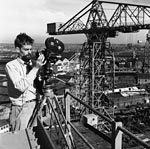






 |
|||||
 |
 |
 |
 |
 |
 |
|
Scottish Film Culture Before 1938 The First Films of Scotland Committee Scottish Film Culture Between the Committees The Second Films of Scotland Committee Production Distribution & Exhibition |
Scottish Film Culture Before 1938The first Films of Scotland Committee was set up in 1938. In a BBC radio programme broadcast the same year, John Grierson (1938, March 31) traced the history of the Films of Scotland Committee to a speech he made in Stirling in 1937 that was taken up by the newspapers, and to the Scottish Film Council's attempt to establish a Scottish film movement. Earlier in the programme Grierson announced; 'This year Scottish pictures are being made under proper Scottish auspices and for the first time' (p. 2). This was not in fact the case. As this section will outline, Scottish pictures were being made under 'proper Scottish auspices' as early as the turn of the century. |
 The First Films of Scotland Committee, set up in 1938 by the Scottish Secretary of State and the Scottish Development Council. Its members included documentary filmmaker John Grierson and authors Neil Gunn and James Bridie. |
The First Scottish FilmsMoving pictures were shown for the first time in Scotland on 13th April 1896, in the Empire Palace Theatre, Edinburgh, then on 26th May at the Skating Palace in Glasgow. Arguably the first Scottish film, The Departure of the Columba from Rothesay Pier (1896), was screened at the Skating Palace in the same year. The Bailie (1896, May 27) reported that 'Nothing could be finer than the representation of the Gordon Highlanders leaving Maryhill Barracks. The picture lasts several minutes, and was repeatedly applauded, as the swinging gate of the Highlanders stirred the patriotism of the audience'. In the same year George Green, a travelling showman, brought moving pictures to Scotland as one of his fairground amusements, screening the films during the Christmas Carnival at Vinegar Hill Show Ground, east of Glasgow Cross (McBain, 1986a). Local TopicalsScottish showmen also shot and screened local scenes
to draw an audience for their moving pictures. This gimmick was picked up by
early cinema exhibitors who made short home made news reels: |
 Promotional films also dominated the work of the second Films of Scotland Committee. The production still above is from Seawards the Great Ships (1960) produced for Clyde Shipbuilders' Association and the Central Office of Information. |
In the late 1890s these local topicals toured various regions of Scotland on circuits that extended up into the Shetlands. One of the exhibitors was William Walker, whose coverage of the 1898 Braemar Gathering was the first film seen by Queen Victoria. It was screened at a Royal Command performance at Balmoral on 28 October 1898. From 1910 Scottish cinematographers began to make short promotional films. These included The Making of a Great Daily Newspaper (1911), produced by D.C. Thomson in Dundee to commemorate the fiftieth anniversary of the Courier as a daily paper, and From Wool to Wearer - The Romance of Pesco Underwear (1913), a film about the manufacture of gentlemen's hosiery commissioned by Peter Scott and Company of Hawick. From 1914 small production companies, such as Paul Robello's Topical Productions were set up. 'Local topicals' became increasingly popular, and in 1918 George Green's family began exhibiting regular issues of their Scottish Moving Picture News, later becoming British Moving Picture News (McBain, 1986b). |
|
|
Promotional Film and Film SocietiesFrom the end of the 1920s a number of production companies were formed to produce commissioned promotional films. In 1928 Scottish Film Productions, later becoming Russell Productions then Thames and Clyde Film Company, was established by Stanley Russell and Malcom Irvine in Glasgow, and in 1930 Campbell Harper films was founded in Edinburgh by Alan Harper (McBain, 1986b). Two other companies specialised in instructional and educational film; Zest Films, set up by Graham Thompson, and Elder Delrimple Films. Delrimple and Jimmy Gillespie filmed their trip from Cape Town to Cairo and screened it to school children in the Gorbals who, as a consequence, probably saw their first camel before they had seen their first cow; an early example of the way in which the mass media, contributed to the experience of the 'shrinking' or compression of space that began in the mid-nineteenth century and that theorists have argued is a formative feature of modernity (cf. Harvey, 1995). During the same period Scottish film culture became increasingly consolidated
at an institutional level with the creation of film societies, guilds
and libraries. In 1929 the Film Society of Glasgow was founded, followed
in 1930 by the Edinburgh Film Guild and the Scottish Educational Cinema
Society, established in the west of Scotland for the production, study
and presentation of educational films. In 1931 Glasgow Co-operative Film
Library was set up, and in 1933 Glasgow mounted Britain's first amateur
film festival. The festival grew out of the Meteor Film Producing Society,
and became the cutting edge of amateur film making with prize-winners
such as Norman Mclaren, Stuart McAllistair and Eddie McConnell quickly
moving into professional production, including work for Films of Scotland. In 1934
the Federation of Scottish Filmmakers Society was formed, in 1935 the
Scottish Educational Cinema Society merged with the SESSA to become the
Scottish Educational Film Association, and in 1936 the Scottish Federation
of Film Societies was founded. |

|
|
| Author: Richard Butt | Images are drawn from the SCRAN database. |